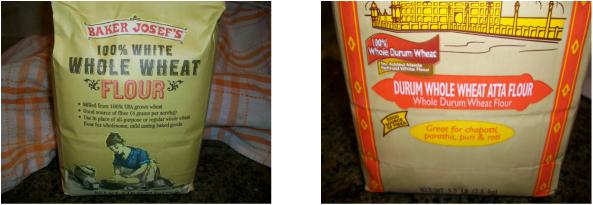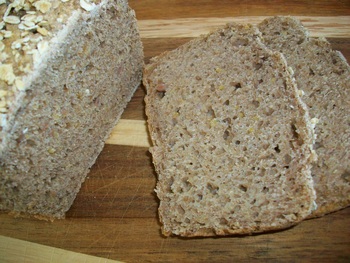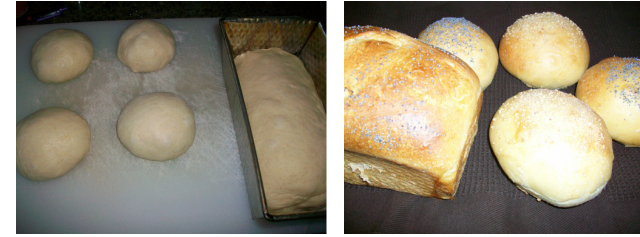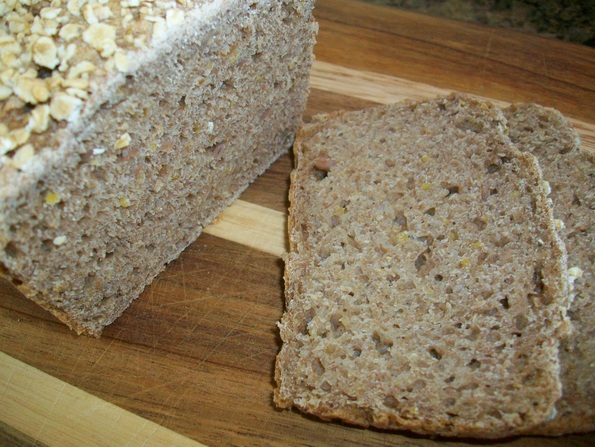We love the taste of whole wheat bread, but because of it's density, I hardly ever make it. This is bread number 41 in the challenge and on page of the Bread Bake's Apprentice, by Peter Reinhart. Reinhart tells the story of wheat bread being the reason for his bread beginnings thirty something years ago, and how complex it can be to actually extract wonderful flavors without leaving a "grassy" or bitter aftertaste. I was in fact inspired by Reinhart's journey in discovering ways of improving flavors from whole wheat and so also obtained a copy of his Whole Grains book. Getting back to the subject at hand, in this particular recipe, there is the use of both a soaker and a poolish or biga, in which the longer fermentaion is supposed to balance out the bitter/grassy notes in the whole grain and improve the crumb somehow.  When I first began to think about this recipe, I decided to try a combination of whole wheat flours to see if there was any difference in flavor. I had a new bag of Trader Joe's white whole wheat, and a fairly new bag of whole wheat durum flour that I thought would make for an interesting mix.  The actual recipe calls for both a soaker of whole grains ( I used the two flours and threw in some corn grits for texture), and a biga. The Biga was actually my wild yeast that was increased to make the appropriate amount for this recipe.  The grains looked full and opened up a great deal after the soak. I combined the rest of the ingredients to make a typical bread dough and let it bulk rise until it doubled in size. The dough was then divided in half to make to loaves and placed inside bread pans.  The resulting bread was actually a lot heavier and dense than I had hoped for, but the the rustic looking loaves had a wonderful tangy taste and was delicious with soups and salads. I will try this again but use different wheat grains next time.
Yeastpotted.
1 Comment
Moving right along, we are at bread #40 in the Bread Baker's Apprentice book, and I can say that I see the light at the end. (I can also certainly say that i was not incredibly excited about tackling this bread, since most white breads have a very boring flavor profile to me.) I have made plenty of white breads in the past, and so I just knew that this was going to be an ordinary loaf. However, since I am only using my wild yeast starter as the sole leavening agent, I was very curious to see what would happen to the flavor and texture once the longer fermentation process was implemented. I chose to tackle variation 3, since it involved a preferment and I was using my sourdough as my leavening agent. Since I am participating in the BBA Challenge, I cannot post the recipe, but someone has posted the recipe for variation 2 here.  This bread actually involved a preferment (A pre-ferment and a longer fermentation in the bread-making process have several benefits: there is more time for yeast, enzyme and, if sourdough, bacterial actions on the starch and proteins in the dough, thereby creating greater complexities of flavor), egg yolk, sugar, and butter to enrich the dough.  After kneading the ingredients together to get a soft dough that window-paned, it was then rolled in an oiled bowl(I used the same mixing bowl) and covered to let double in bulk.  The dough was divided after fermenting and shaped into a loaf and 4 sandwich buns. I opted to sprinkle the top with poppy seeds.
The verdict? Well, let's just say that this was the BEST white bread we have ever eaten. The sponge or preferment, really gave the bread wonderful flavor, and the fat from the butter and egg yolk softened the crumb which gave a more delicate texture. What a wonderful surprise! yeastpotted. |


 RSS Feed
RSS Feed